If you've searched Google for "sprint retrospective meeting agenda template" or "what happens in sprint retrospective meetings," you've come to the right place.
In this article, I want to take you along and show you what our sprint retrospective meeting agendas look like. I'll show you all the important aspects we've learned from over 30,000 agile retrospective meetings, including screenshots and free direct access if you want to set up a retrospective agenda yourself.
Sprint Retrospective Meeting Agenda Template
The building blocks of a successful retrospective agenda
First of all, I want to introduce you to several "building blocks" that you can use to put together your own Scrum retrospective agenda. In this case, I've chosen an order that already builds up to a nice agenda for an agile retrospective. But please keep in mind that you can restructure these building blocks however you like, or even leave some out, to still create a nice agenda for a sprint retrospective.
To do this, just think about how much time you have for the retrospective meeting and whether you and your team feel like doing all these different steps.
Prepare a retrospective:
Before you can hold a successful retrospective, you must first prepare it. In this first step, we need to distinguish between you as the organizer of the session and the people who are only attending the session as participants.
1. select the appropriate retro format
You may have heard of the "What Went Well Retrospective" or the "Sailboat Retro." In both cases, these are a series of questions asked during the retrospective. These questions are often considered the heart of the retrospective. So it's best to prepare some interesting questions that your team can use to reflect on what happened during the last sprint cycle. There are many retrospective templates for this purpose. For example, we wrote an article about more than 50+ retrospective templates and also in our Echometer tool you can choose between all these different templates as presets.
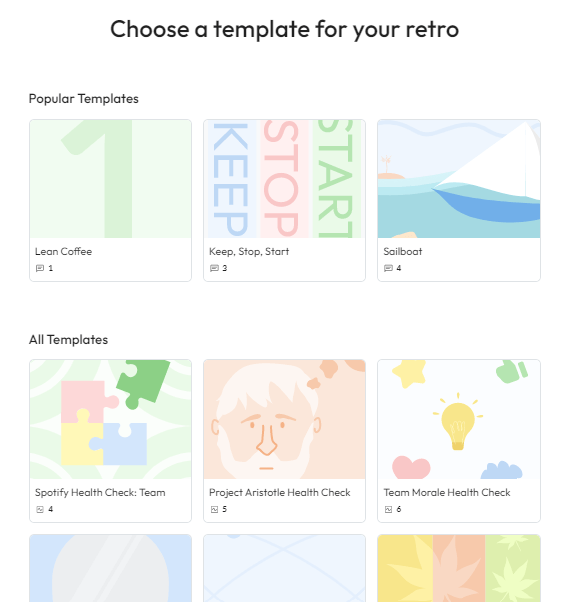
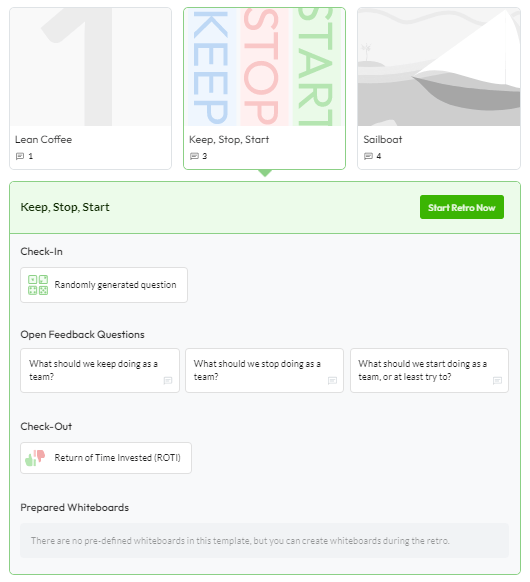
In this case, you see a small selection of retrospective templates on the left, and on the right you can see that if you choose to use the "Keep, Stop, Start Retrospective," for example, you can still customize the questions to meet your team's needs.
2. collect information
After choosing the right template for you and your team, I like to send a retro survey to team members so they can answer the questions that will be asked in the retrospective ahead of time. This leads to a shorter duration of the retrospective itself and has been proven to make it more successful. That said, answering this survey in advance is not a must, but rather an option if you and your team are comfortable doing so. If you decide to send out a survey to your team members, you can do so in the Echometer tool with a simple click of a button.
You want to prepare a retrospective yourself in no time? Then you should check out our tool for free:
The procedure of a retrospective:
Now that you have made all the preparations for the retrospective, you and your team can start it. The following is the retrospective process I usually use:
It is important to mention here again that you do not have to follow this pure sequence. You can even omit individual parts if necessary. You can simply decide whether they meet the needs of your team or not.
3. retrospective check-in / icebreaker
To get the retrospective going and everyone in the right mood, we use so-called "icebreakers". An icebreaker is a simple question at the beginning of the retrospective to get all team members involved and have them tell a short story, for example, about their last days at work. It is important that this step is not too long. We usually ask a fun little question and give all team members 20 seconds to think about it and then 30 seconds to a minute to talk about it. One of my personal favorite icebreakers is the "What animal – Icebreaker."
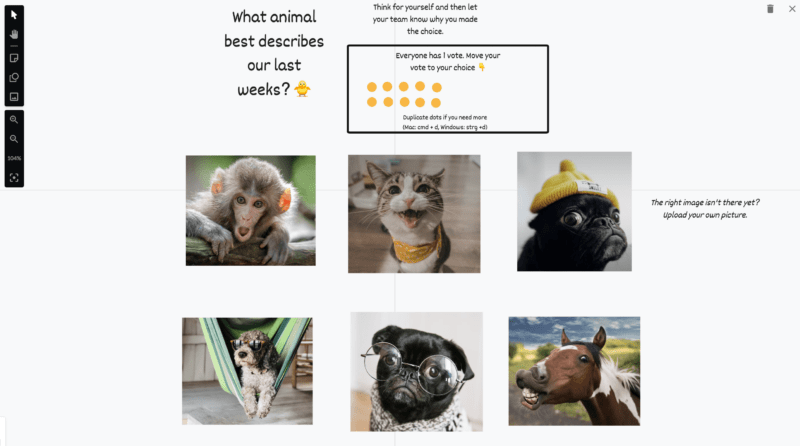
As you can see, this first step is designed to put all team members in a good mood and get them involved in the session for the first time. These icebreakers don't have to include funny animal pictures, but can also be simple questions like "How has your day been so far?".
But if you have the option to make it more fun, why not?
In the Echometer tool, you can choose from different icebreaker templates, such as the "Which animal – Icebreaker", or you can even start the retro with a random icebreaker picked for you to add more variety.
4. action item review
After a brief check-in, the next step in my sprint retrospective meetings is what I call the "action item review." To put it in simple terms: All action items or measures that were decided in the last sprint are briefly discussed.
If this is your first retrospective with a team and you haven't formulated any action items yet, you can skip this step. I will come back to it later when it is time to formulate new action items.
If you already have action items, you must now check for each action item:
– Did we implement the action item as planned? ("Check")
– Do we need to take more time to do this? ("Re-Do")
– Do we discard the action item due to new information? ( cancle )
In our tool it looks something like this:

After you've reviewed all the action items, you'll move on to the next step of the Sprint Retrospective Meeting Agenda....
5. data collection 2.0
If you haven't already done it before the retrospective by taking a survey, your team can now answer all the questions in the retrospective template that you chose.
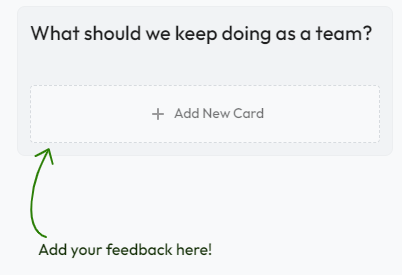
Typically, we don't just answer the retrospective questions, but randomly mix in two so-called "health check items" to gauge the team's sentiment on various topics:

This gives you the opportunity to measure the health of your team not only selectively, but also over time. In the Echometer tool, an automatic statistic is created that measures how "healthy" your team is right now compared to other time periods. This allows you to spot early warning signs and take countermeasures before the team's performance plummets.
When you are done collecting information, I usually give each team member the opportunity to briefly present their answers. This is only to get a first small impression in a short time and not yet to deepen the answers. That happens only in the next step...
6. deeper insight and action item creation
At this point in the Sprint Retrospective meeting agenda, we want to dive deeper into the team members' responses to the retrospective questions. To approach this strategically, we first give team members the opportunity to vote on which items they want to cover in more depth in the retrospective. At Echometer, we do this by giving team members voting points that they can individually assign to responses. Our tool automatically calculates how many voting points we assign to each member to keep the meeting effective (In this example, 2 votes per user is highlighted in blue).

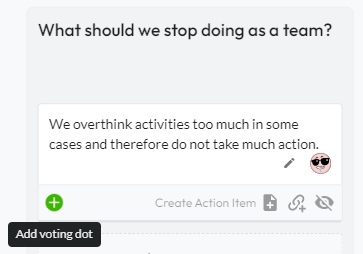
After that, we talk about the answers we voted for. While we then talk about the individual items, we develop measures to improve the work in the team. These are the so-called "Action Items", which we want to implement in the Sprint Cycle and review again in the next Retrospective. As you can see in the picture, you can attach the action items directly to the meeting points in our tool.
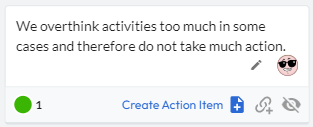
Now that we've created new Action Items for the next Sprint Cycle, there's just one more small, but impactful step to take....
7. the retrospective feedback
Even though the retrospective is over, we want to take the opportunity to learn from it. For you, as the retrospective facilitator, it's not only your job to conduct the retrospective, but also to make sure it's better and more customized to your team each time. To do this, at Echometer we simply ask for the so-called ROTI score. The ROTI (return on time invested) score is a subjective metric where participants can rate the retrospective on a scale of 1 to 10. This provides quick feedback on how good the retrospective was and also allows you to compare how the ROTI score behaves over time to see if the overall mood is moving in the right direction.
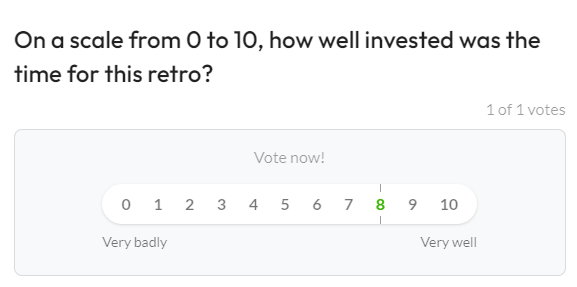
Sprint Retrospective Meeting Agenda Template
Conclusion – The structure of a Sprint Retrospective
I hope I was able to give you a good overview of how I plan and implement my retrospective meetings in no time. If you're interested in planning your own sprint retrospectives professionally, you can do so for free in our Echometer tool.
Keep in mind that the tools presented are only a sample of the entire spectrum of the Echometer universe. Whiteboards, statistics and the Health Check Radar are just a few more examples.
So don't hesitate, just click the button and try our tool without registration:








